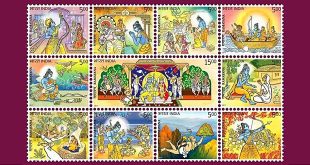Bala Kand — The Bala Kand describes the birth of Rama, his childhood and marriage to Sita.
This opening part begins with the description of Brahmaswarup, that is, the cosmic and celestial appearance of Lord Rama, his avatar as a human being to remove the asuras (demons) like Ravana; Rama’s childhood; story of emancipation of Ahilya by Rama.
Introduction
Dasharatha was the king of Kosala, the capital of which was the city of Ayodhya. He had three queens: Kausalya, Kaikeyi and Sumitra. He was childless for a long time and, anxious to produce an heir, he performs a fire sacrifice known as Putra-Kameshti Yagya. As a consequence, Rama is first born to Kausalya, Bharata is born to Kaikeyi, and Sumitra gives birth to twins named Lakshmana and Shatrughna. These sons are endowed, to various degrees, with the essence of the God Vishnu; Vishnu had opted to be born into mortality in order to combat the demon Ravana, who was oppressing the Gods, and who could only be destroyed by a mortal. The boys are reared as the princes of the realm, receiving instructions from the scriptures and in warfare. When Rama is 16 years old, the sage Vishwamitra comes to the court of Dasharatha in search of help against demons, who were disturbing sacrificial rites. He chooses Rama, who is followed by Lakshmana, his constant companion throughout the story. Rama and Lakshmana receive instructions and supernatural weapons from Vishwamitra, and proceed to destroy the demons.
Janaka was the king of Mithila. One day, a female child was found in the field by the king in the deep furrow dug by this plough. Overwhelmed with joy, the king regarded the child as a “miraculous gift of God”. The child was named Sita, the Sanskrit word for furrow. Sita grew up to be a girl of unparalleled beauty and charm. When Sita was of marriageable age, the king decided to have a swayamvara which included a contest. The king was in possession of an immensely heavy bow, presented to him by the God Shiva: whoever could wield the bow could marry Sita. The sage Vishwamitra attends the swayamvara with Rama and Lakshmana. Only Rama wields the bow and breaks it. Marriages are arranged between the sons of Dasharatha and daughters, nieces of Janaka. The weddings are celebrated with great festivity at Mithila and the marriage party returns to Ayodhya.
 Kids Portal For Parents India Kids Network
Kids Portal For Parents India Kids Network

